The Role of Sulphate and Phosphate Ions in the Recovery of Benzoic Acid Self-Enhanced Ozonation in Water Containing Bromides
Abstract
:1. Introduction

2. Results and Discussion
2.1. Ozone Decomposition
2.2. BA Degradation
2.3. Recovery of the Radical Process at Low pH
3. Materials and Methods
Calculations
- -
- fraction of •OH reacted with benzoic acid (∫OH-BA):
- fraction of •OH reacted with phosphate or sulphate (∫OH-P/S:):
- fraction of •OH reacted with bromide (∫OH-Br:):where in Equations (13)–(15):
- -
- fraction of phosphate/sulphate radicals reacted with benzoic acid (∫P/S-BA):
- fraction of phosphate/sulphate radicals reacted with bromide (∫P/S-Br):
- fraction of phosphate/sulphate radical recombination (∫P/S-S/P):where in Equations (22)–(24):
4. Conclusions
- Bromides strongly inhibit the process of self-enhanced ozonation. The research showed a quantitative relationship between the concentration of bromides in the solution and the effectiveness of benzoic acid removal. It was shown that the addition of only 15 µM of bromides completely inhibits the BA degradation process. However, the introduction of phosphates into ozonated water containing bromides contributes to recovery of the reaction and increases the efficiency of BA oxidation.
- This paper shows, for the first time, that the process of radical degradation of pollutants in the presence of a halogen ion is also possible by introducing sulphates into ozonated water. Such a solution opens the possibility of industrial application of the results presented in the paper.
- Bromides inhibit the ozonation process more strongly in the presence of sulphates than in the presence of phosphates.
- Phosphates and sulphates in ozonated water may form radicals capable of oxidizing organic pollutants, and therefore their appropriate excess over bromides can contribute to increasing the efficiency of benzoic acid degradation.
- The recovery of benzoic acid ozonation in the presence of bromides occurs most likely as a result of secondary reactions with phosphate and sulphate radicals. Calculations showed that the efficiency of benzoic acid oxidation by phosphate radicals is lower than by sulphate radicals, however, phosphate radicals are generated to a greater extent.
- The discussed recovery processes are initiated by hydroxyl radicals, which was confirmed by their inhibition in the presence of TBA.
- The results obtained in the study indicate that carrying out radical processes in the presence of bromides is possible. This implies that using the proposed solution in the treatment of water and waste water, regardless of the pH and salinity, is possible.
Author Contributions
Funding
Institutional Review Board Statement
Informed Consent Statement
Data Availability Statement
Acknowledgments
Conflicts of Interest
References
- Nawrocki, J.; Kasprzyk-Hordern, B. The efficiency and mechanisms of catalytic ozonation. Appl. Catal. B Environ. 2010, 99, 27–42. [Google Scholar] [CrossRef]
- Nawrocki, J.; Fijołek, L. Mechanisms and Efficiency of Catalytic Ozonation in Water Treatment. Ochr. Srodowiska 2009, 31, 3–16. [Google Scholar]
- Staehelin, J.; Hoigne, J. Decomposition of ozone in water in the presence of organic solutes acting as promoters and inhibitors of radical chain reactions. Environ. Sci. Technol. 1985, 19, 1206–1213. [Google Scholar] [CrossRef] [PubMed]
- Pi, Y.; Schumacher, J.; Jekel, M. Decomposition of aqueous ozone in the presence of aromatic organic solutes. Water Res. 2005, 39, 83–88. [Google Scholar] [CrossRef]
- Buffle, M.-O.; Von Gunten, U. Phenols and Amine Induced HO•Generation During the Initial Phase of Natural Water Ozonation. Environ. Sci. Technol. 2006, 40, 3057–3063. [Google Scholar] [CrossRef]
- Huang, X.; Li, X.; Pan, B.; Li, H.; Zhang, Y.; Xie, B. Self-enhanced ozonation of benzoic acid at acidic pHs. Water Res. 2015, 73, 9–16. [Google Scholar] [CrossRef] [PubMed]
- Fijołek, L.; Nawrocki, J. Phosphate helps to recover from scavenging effect of chloride in self-enhanced ozonation. Chemosphere 2018, 212, 802–810. [Google Scholar] [CrossRef]
- Grebel, J.; Pignatello, J.; Mitch, W.A. Effect of Halide Ions and Carbonates on Organic Contaminant Degradation by Hydroxyl Radical-Based Advanced Oxidation Processes in Saline Waters. Environ. Sci. Technol. 2010, 44, 6822–6828. [Google Scholar] [CrossRef]
- Qi, S.; Mao, Y.; Lv, M.; Sun, L.; Wang, X.; Yang, H.; Xie, Y.F. Pathway fraction of bromate formation during O3 and O3/H2O2 processes in drinking water treatment. Chemosphere 2016, 144, 2436–2442. [Google Scholar] [CrossRef] [PubMed]
- Yang, Y.; Pignatello, J.J.; Ma, J.; Mitch, W.A. Comparison of Halide Impacts on the Efficiency of Contaminant Degradation by Sulfate and Hydroxyl Radical-Based Advanced Oxidation Processes (AOPs). Environ. Sci. Technol. 2014, 48, 2344–2351. [Google Scholar] [CrossRef]
- Glaze, W.H.; Kang, J.W. Advanced oxidation processes: test of a kinetic model for the oxidation of organic compounds with ozone and hydrogen peroxide in a semibatch reactor. Ind. Eng. Chem. Res. 1989, 28, 1580–1587. [Google Scholar] [CrossRef]
- Lee, B.-N.; Liaw, W.-D.; Lou, J.-C. Photocatalytic Decolorization of Methylene Blue in Aqueous TiO2 Suspension. Environ. Eng. Sci. 1999, 16, 165–175. [Google Scholar] [CrossRef]
- Liao, C.-H.; Kang, S.-F.; Wu, F.-A. Hydroxyl radical scavenging role of chloride and bicarbonate ions in the H2O2/UV process. Chemosphere 2001, 44, 1193–1200. [Google Scholar] [CrossRef]
- Lou, X.; Xiao, D.; Fang, C.; Wang, Z.; Liu, J.; Guo, Y.; Lu, S. Comparison of UV/hydrogen peroxide and UV/peroxydisulfate processes for the degradation of humic acid in the presence of halide ions. Environ. Sci. Pollut. Res. 2016, 23, 4778–4785. [Google Scholar] [CrossRef] [PubMed]
- Lu, M.-C.; Chen, J.-N.; Chang, C.-P. Effect of inorganic ions on the oxidation of dichlorvos insecticide with Fenton’s reagent. Chemosphere 1997, 35, 2285–2293. [Google Scholar] [CrossRef]
- Olson, T.M.; Barbier, P.F. Oxidation kinetics of natural organic matter by sonolysis and ozone. Water Res. 1994, 28, 1383–1391. [Google Scholar] [CrossRef]
- Tang, W.Z.; Huang, C.P. 2,4-Dichlorophenol Oxidation Kinetics by Fenton’s Reagent. Environ. Technol. 1996, 17, 1371–1378. [Google Scholar] [CrossRef]
- Yang, J.; Li, J.; Dong, W.; Ma, J.; Yang, Y.; Li, J.; Yang, Z.; Zhang, X.; Gu, J.; Xie, W.; et al. Enhancement of bromate formation by pH depression during ozonation of bromide-containing water in the presence of hydroxylamine. Water Res. 2017, 109, 135–143. [Google Scholar] [CrossRef]
- Concise International Chemical Assessment Document 26, BENZOIC ACID AND SODIUM BENZOATE, First Draft Prepared by Dr A. Wibbertmann, Dr J. Kielhorn, Dr G. Koennecker, Dr I. Mangelsdorf, and Dr C. Melber, Fraunhofer Institute for Toxicology and Aerosol Research, Hanover, Germany, World Health Organization Geneva. 2000. Available online: https://www.who.int/ipcs/publications/cicad/cicad26_rev_1.pdf (accessed on 21 April 2021).
- Dorfman, L.M.; Adams, G.E. Reactivity of the Hydroxyl Radical in Aqueous Solutions; NSRDS: Washington, DC, USA, 1973. [Google Scholar]
- Mártire, D.O.; Gonzalez, M.C.; Gonzalez, C. Aqueous Phase Kinetic Studies Involving Intermediates of Environmental Interest: Phosphate Radicals and Their Reactions with Substituted Benzenes. Prog. React. Kinet. Mech. 2001, 26, 201–218. [Google Scholar] [CrossRef]
- Khan, J.A.; He, X.; Khan, H.M.; Shah, N.S.; Dionysiou, D.D. Oxidative degradation of atrazine in aqueous solution by UV/H2O2/Fe2+, UV//Fe2+ and UV//Fe2+ processes: A comparative study. Chem. Eng. J. 2013, 218, 376–383. [Google Scholar] [CrossRef]
- Antoniou, M.G.; De La Cruz, A.A.; Dionysiou, D.D. Degradation of microcystin-LR using sulfate radicals generated through photolysis, thermolysis and e− transfer mechanisms. Appl. Catal. B Environ. 2010, 96, 290–298. [Google Scholar] [CrossRef]
- Maruthamuthu, P.; Neta, P. Reactions of phosphate radicals with organic compounds. J. Phys. Chem. 1977, 81, 1622–1625. [Google Scholar] [CrossRef]
- Rosso, J.A.; Caregnato, P.; Mora, V.C.; Gonzalez, M.C.; Mártire, D.O. Reactions of Phosphate Radicals with Monosubstituted Benzenes. A Mechanistic Investigation. Helvetica Chim. Acta 2003, 86, 2509–2524. [Google Scholar] [CrossRef]
- Rosso, J.A.; Nieto, F.J.R.; Gonzalez, M.C.; Mártire, D.O. Reactions of phosphate radicals with substituted benzenes. J. Photochem. Photobiol. A Chem. 1998, 116, 21–25. [Google Scholar] [CrossRef]
- Maruthamuthu, P.; Neta, P. Phosphate radicals. Spectra, acid-base equilibriums, and reactions with inorganic compounds. J. Phys. Chem. 1978, 82, 710–713. [Google Scholar] [CrossRef]
- Zhou, T.; Zou, X.; Mao, J.; Wu, X. Decomposition of sulfadiazine in a sonochemical Fe0-catalyzed persulfate system: Parameters optimizing and interferences of wastewater matrix. Appl. Catal. B Environ. 2016, 185, 31–41. [Google Scholar] [CrossRef]
- Ross, A.B.; Neta, P. Rate Constants for Reactions of Inorganic Radicals in Aqueous Solution; NSRDS: Washington, DC, USA, 1979. [Google Scholar]
- Dong, H.; Wei, G.; Fan, W.; Ma, S.; Zhao, H.; Zhang, W.; Guan, X.; Strathmann, T.J. Reinvestigating the role of reactive species in the oxidation of organic co-contaminants during Cr(VI) reactions with sulfite. Chemosphere 2018, 196, 593–597. [Google Scholar] [CrossRef]
- Neta, P.; Madhavan, V.; Zemel, H.; Fessenden, R.W. Rate constants and mechanism of reaction of sulfate radical anion with aromatic compounds. J. Am. Chem. Soc. 1977, 99, 163–164. [Google Scholar] [CrossRef]
- Neta, P.; Huie, R.E.; Ross, A.B. Rate Constants for Reactions of Inorganic Radicals in Aqueous Solution. J. Phys. Chem. Ref. Data 1988, 17, 1027–1284. [Google Scholar] [CrossRef]
- Armstrong, D.A.; Huie, R.E.; Koppenol, W.H.; Lymar, S.V.; Merényi, G.; Neta, P.; Ruscic, B.; Stanbury, D.M.; Steenken, S.; Wardman, P. Standard electrode potentials involving radicals in aqueous solution: inorganic radicals (IUPAC Technical Report). Pure Appl. Chem. 2015, 87, 1139–1150. [Google Scholar] [CrossRef]
- Zhou, L.; Yan, C.; Sleiman, M.; Ferronato, C.; Chovelon, J.-M.; Wang, X.; Richard, C. Sulfate radical induced degradation of β2-adrenoceptor agonists salbutamol and Terbutaline: Implication of halides, bicarbonate, and natural organic matter. Chem. Eng. J. 2019, 368, 252–260. [Google Scholar] [CrossRef]
- Bharadwaj, L.M.; Sharma, D.N.; Gupta, Y.K. Kinetics and Mechanism of Oxidations by Peroxydiphosphate. 2. Oxidation of Bromide in Aqueous Perchloric Acid Solution. Inorg. Chem. 1976, 15, 1695–1697. [Google Scholar] [CrossRef]
- Bader, H.; Hoigné, J. Determination of ozone in water by the indigo method. Water Res. 1981, 15, 449–456. [Google Scholar] [CrossRef]
- Ignat’Ev, A.N.; Pryakhin, A.N.; Lunin, V.V. Mathematical simulation as a method to study the influence of oxygen, hydrogen peroxide, and phosphate and carbonate ions on the kinetics of ozone decomposition in aqueous solution. Russ. Chem. Bull. 2009, 58, 1097–1105. [Google Scholar] [CrossRef]
- Farhat, A.; Keller, J.; Tait, S.; Radjenovic, J. Assessment of the impact of chloride on the formation of chlorinated by-products in the presence and absence of electrochemically activated sulfate. Chem. Eng. J. 2017, 330, 1265–1271. [Google Scholar] [CrossRef]
- Lutze, H.V.; Kerlin, N.; Schmidt, T.C. Sulfate radical-based water treatment in presence of chloride: Formation of chlorate, inter conversion of sulfate radicals into hydroxyl radicals and influence of bicarbonate. Water Res. 2015, 72, 349–360. [Google Scholar] [CrossRef] [PubMed]
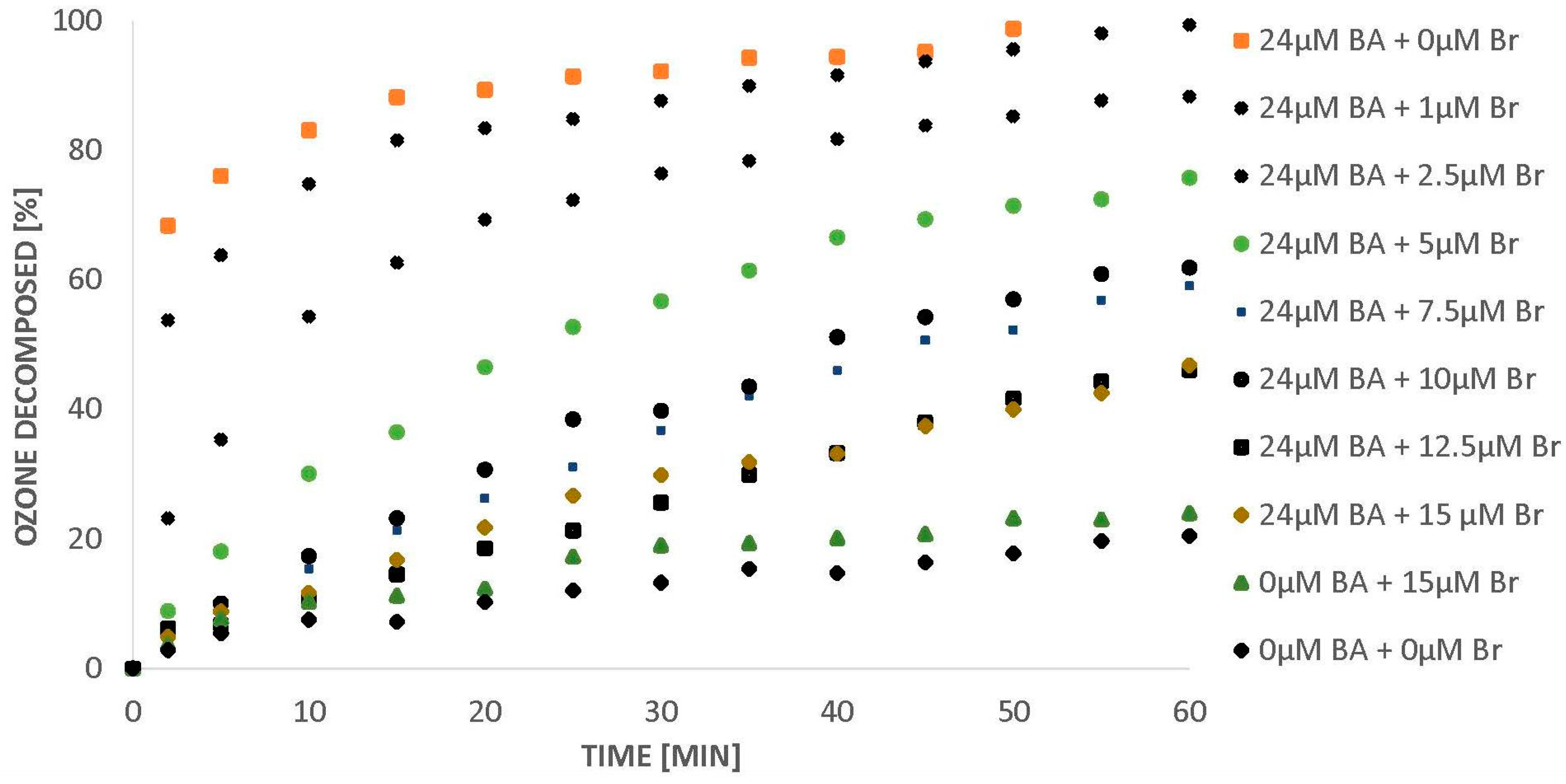
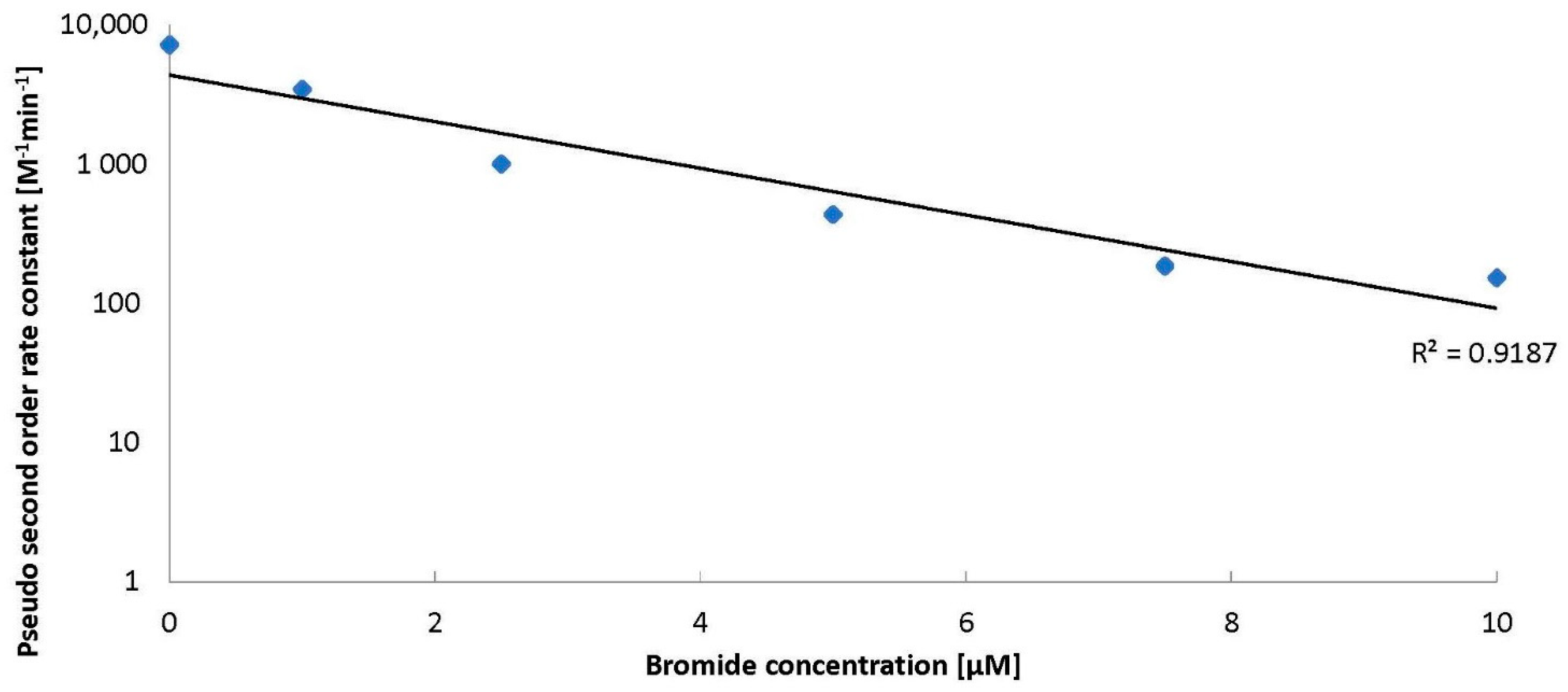
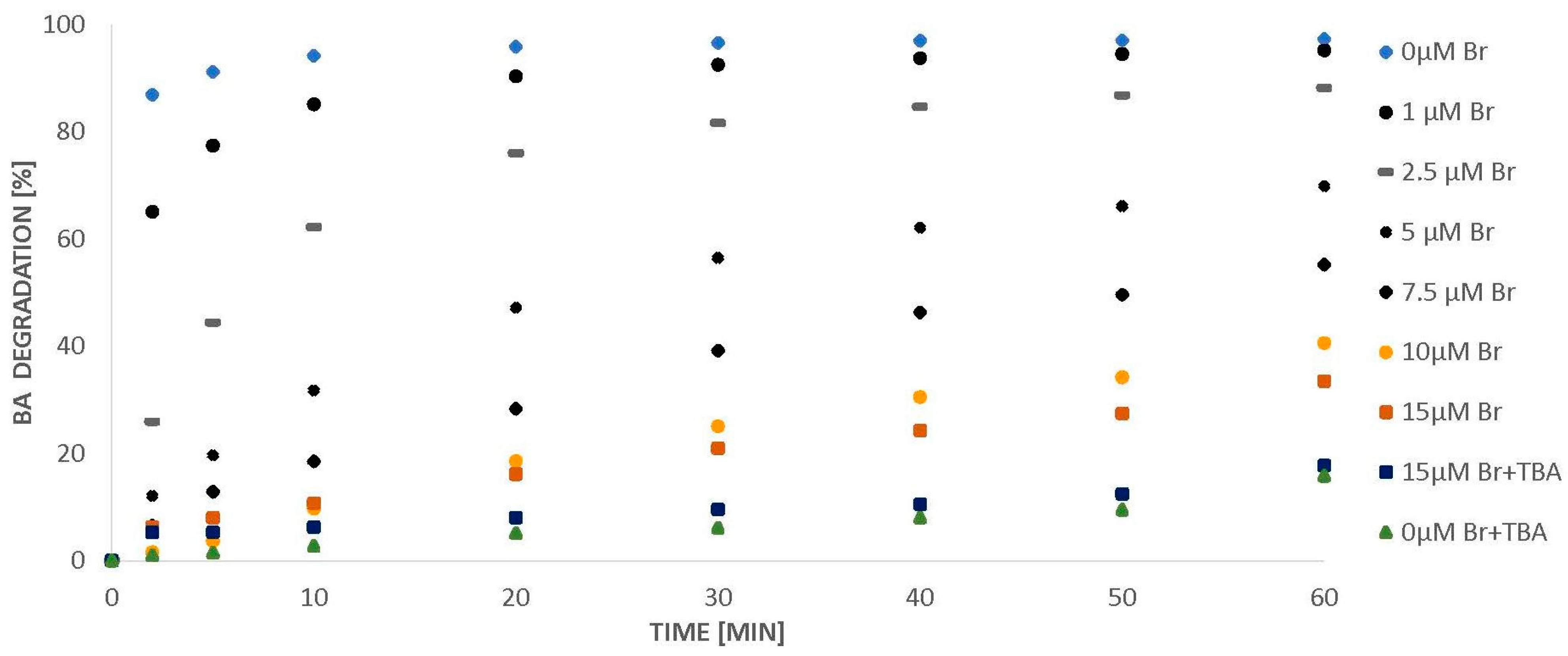
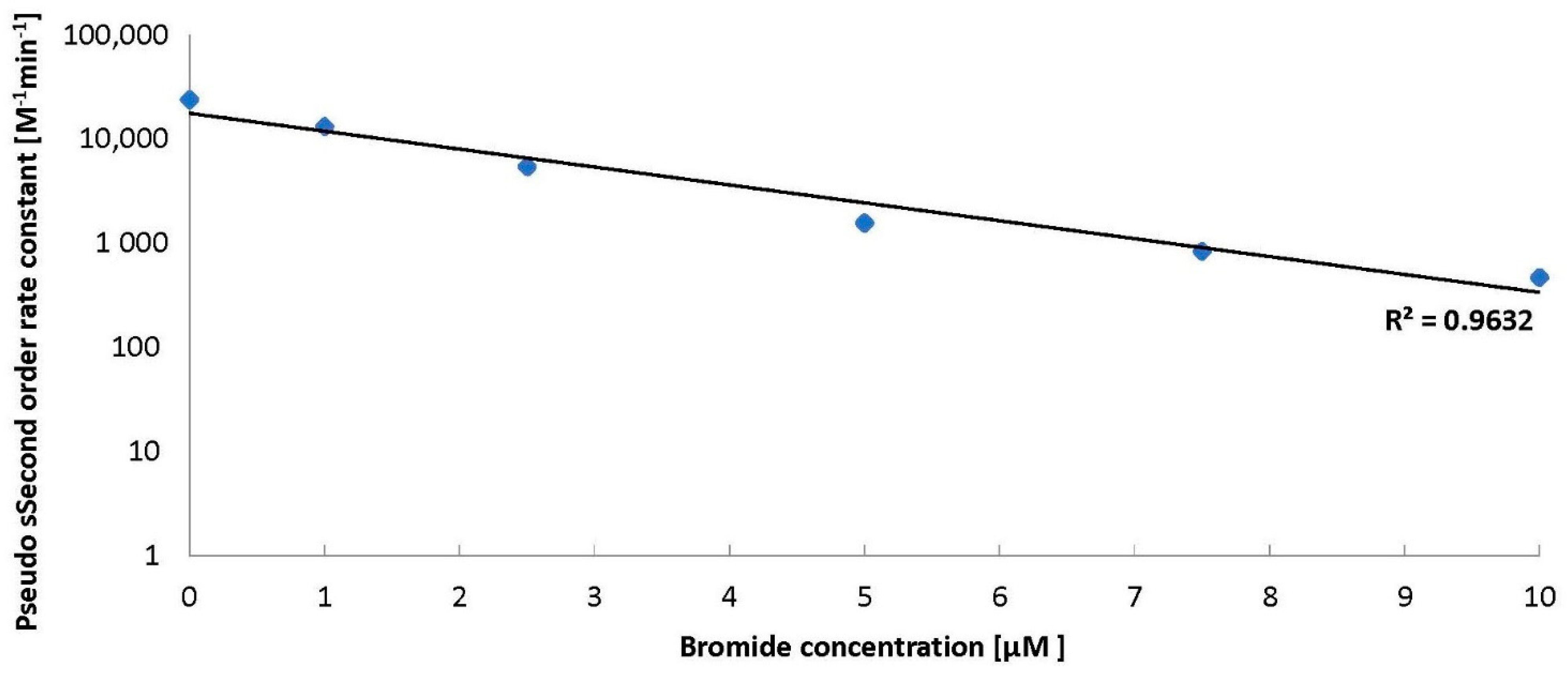
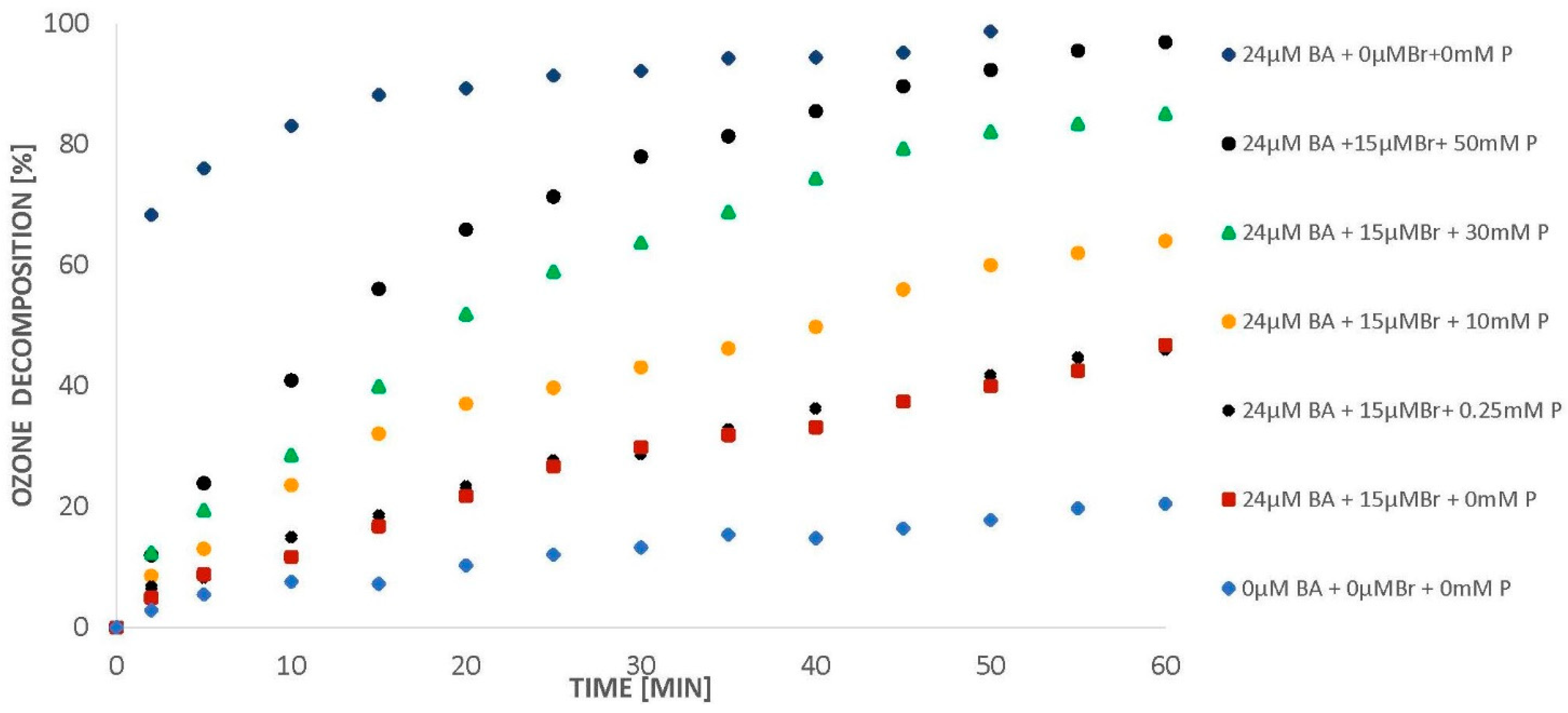
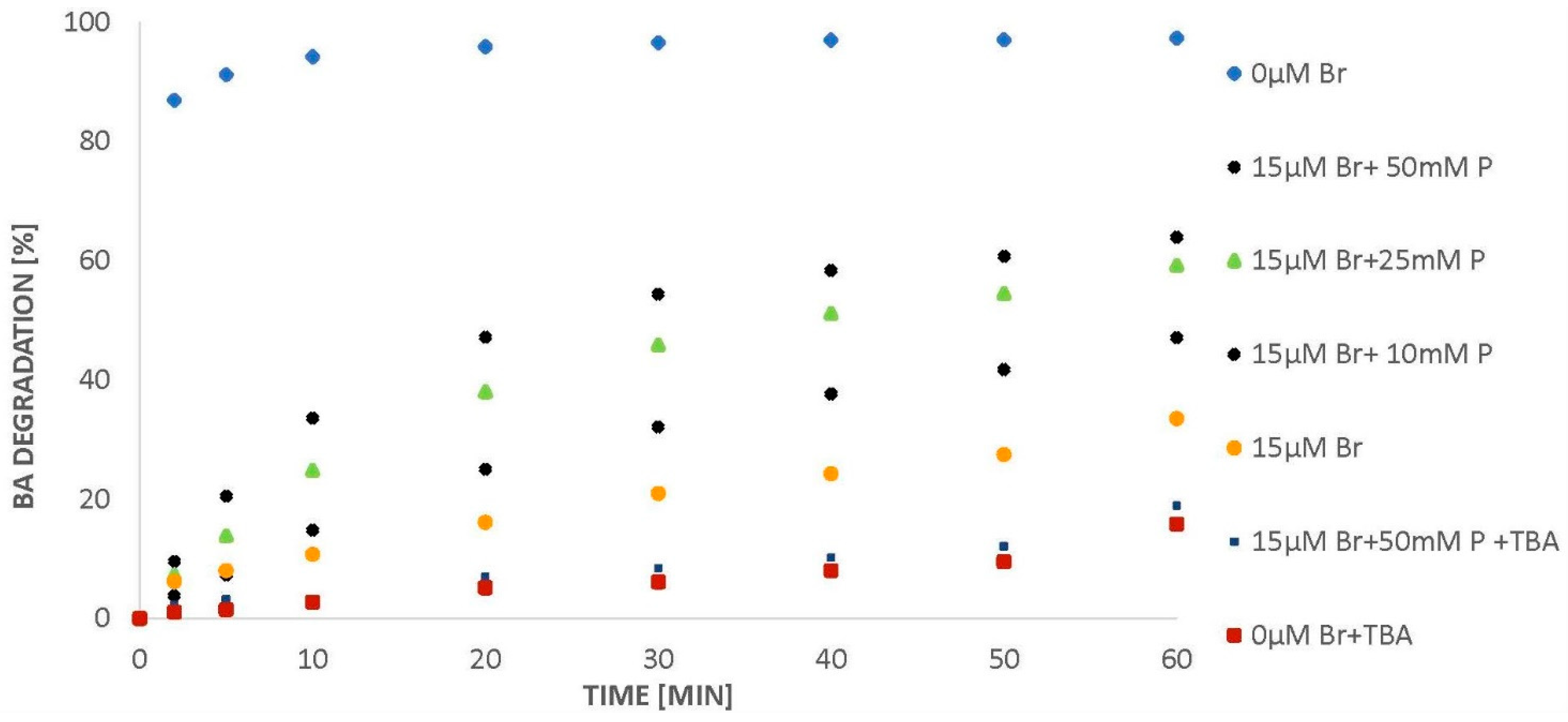
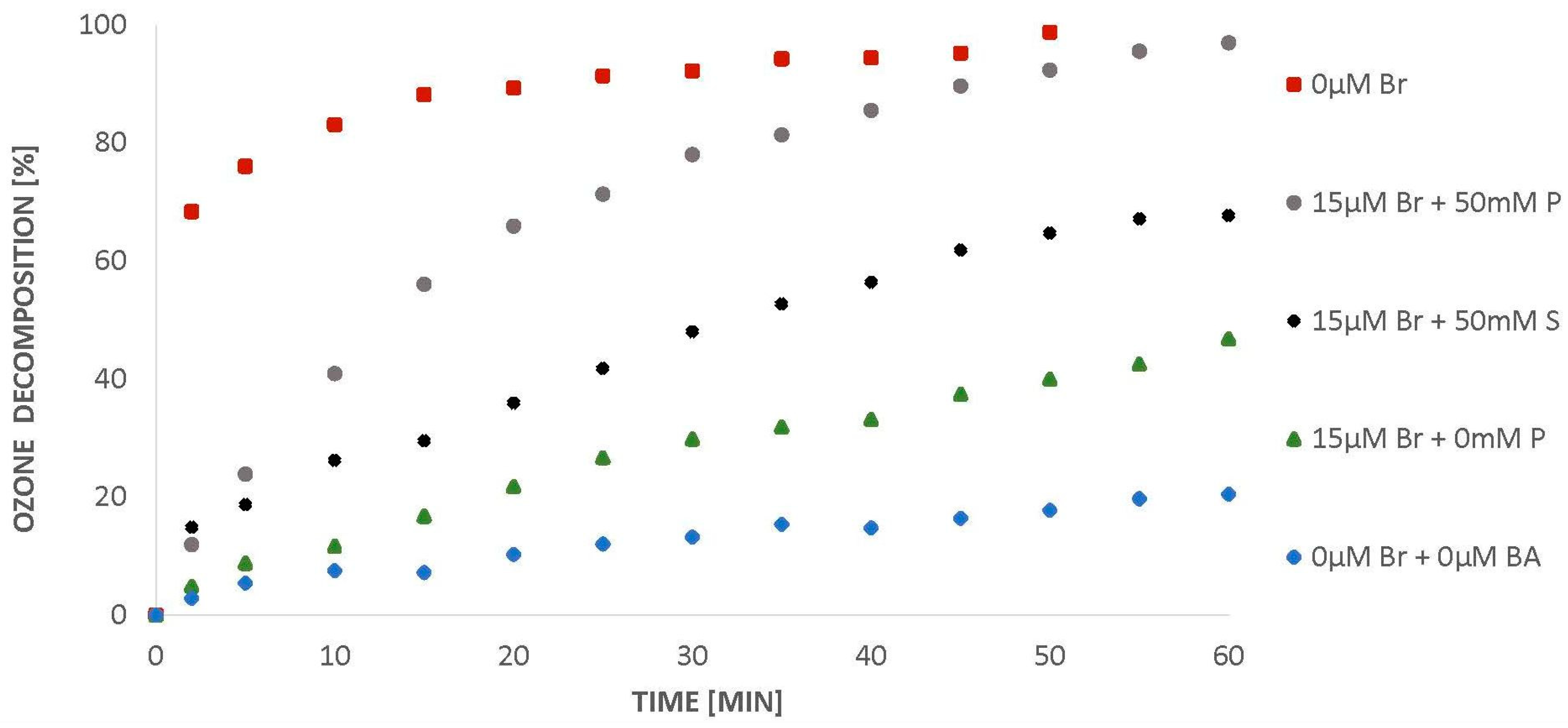
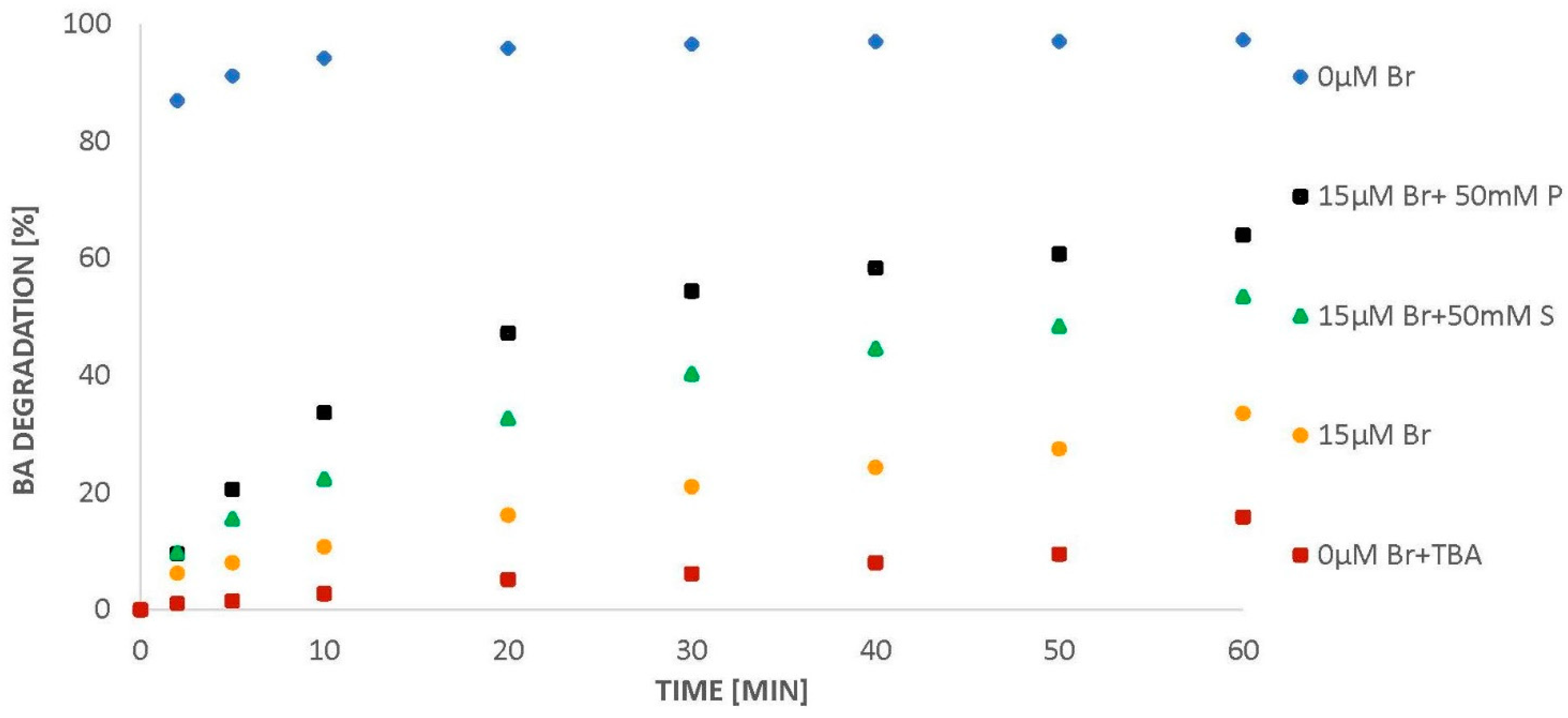
| Process | Processes with Phosphates (P) | Processes with Sulphates (S) | ||||
|---|---|---|---|---|---|---|
| BA | P | Bromides | BA | S | Bromides | |
| with P/S | 33.7 | 28.9 | 37.4 | 39.1 | 15.9 | 44.4 |
| without P/S | 47.3 | - | 52.7 | 47.3 | - | 52.7 |
| Phosphate Radicals | Sulphate Radicals | ||||
|---|---|---|---|---|---|
| Benzoic Acid | Bromide | Recombination | Benzoic Acid | Bromide | Recombination |
| 9.1 | 16.2 | 74.7 | 33.1 | 60.2 | 6.7 |
Publisher’s Note: MDPI stays neutral with regard to jurisdictional claims in published maps and institutional affiliations. |
© 2021 by the authors. Licensee MDPI, Basel, Switzerland. This article is an open access article distributed under the terms and conditions of the Creative Commons Attribution (CC BY) license (https://creativecommons.org/licenses/by/4.0/).
Share and Cite
Fijołek, L.; Świetlik, J.; Frankowski, M. The Role of Sulphate and Phosphate Ions in the Recovery of Benzoic Acid Self-Enhanced Ozonation in Water Containing Bromides. Molecules 2021, 26, 2701. https://doi.org/10.3390/molecules26092701
Fijołek L, Świetlik J, Frankowski M. The Role of Sulphate and Phosphate Ions in the Recovery of Benzoic Acid Self-Enhanced Ozonation in Water Containing Bromides. Molecules. 2021; 26(9):2701. https://doi.org/10.3390/molecules26092701
Chicago/Turabian StyleFijołek, Lilla, Joanna Świetlik, and Marcin Frankowski. 2021. "The Role of Sulphate and Phosphate Ions in the Recovery of Benzoic Acid Self-Enhanced Ozonation in Water Containing Bromides" Molecules 26, no. 9: 2701. https://doi.org/10.3390/molecules26092701
APA StyleFijołek, L., Świetlik, J., & Frankowski, M. (2021). The Role of Sulphate and Phosphate Ions in the Recovery of Benzoic Acid Self-Enhanced Ozonation in Water Containing Bromides. Molecules, 26(9), 2701. https://doi.org/10.3390/molecules26092701








